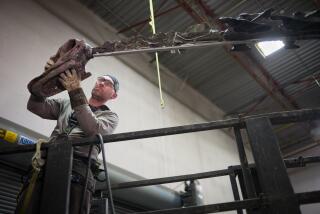Truth About Wally: He’s All Alligator
- Share via
Caiman fanciers, brace yourselves.
Wally, the 5 1/2-foot reptile who was netted on an Irvine street Sunday after three years of living off the ducks and fish of Newport Bay, is a male alligator after all, Harvey Fischer, curator of reptiles for the Los Angeles Zoo, determined Tuesday.
One day earlier, California Fish and Game biologists had insisted that Wally was not an alligator but a spectacled caiman, an alligator-like reptile that frequents the warm, sluggish waters of the Amazon.
‘Little on the Thin Side’
But Tuesday, after Irvine Animal Services officials removed Wally from the dog kennel that had housed him for two days and carted him to temporary quarters at the Los Angeles Zoo, curator Fischer inspected the reptile and concluded that he was an alligator--specifically, a small, healthy, approximately 4-year-old male.
At 30 pounds, “he’s perhaps a little on the thin side,” Fischer said, “but it’s hard to judge. We don’t normally deal with wild alligators.”
Wally is believed to be a former pet whose owner tired of him and dumped him in Newport Bay three years ago, where several sightings of an alligator have been reported since.
Wally’s markings, bands of black and yellow on his tail, were not consistent with the markings of a caiman and his head did not bear the caiman’s distinctive bony ridge, Fischer said. Instead, he appears to be an American alligator, Fischer said. (The only other kind of alligator is Chinese, the curator said. “And he’s certainly not Chinese.”)
But if Wally’s species--and his sex--was determined Tuesday, that did not resolve the question of what to do with him.
Although alligators are protected animals in most parts of the country, most zoos, including Los Angeles’, are not interested in acquiring him, Fischer said.
“He’s not that impressive a specimen,” Fischer said. More to the point, a 5 1/2-foot alligator would not be compatible with the zoo’s current batch of alligators, males that are over 10 feet long and females that are six to eight feet long.
‘Won’t Be Destroyed
If Wally were placed with the zoo’s males, “they would bite him,” Fischer said, “And we’re not going to set up a separate exhibit for one small alligator.”
Still, Fischer said Wally would not be destroyed. Instead, Fischer said he was taking over the task that state wildlife and Irvine animal shelter officials have been grappling with since Sunday--finding a suitable home for a 5 1/2-foot alligator.
So far, three California zoos have declined to take Wally, state game warden Randy Darnall said Tuesday. Fischer and Darnall are seeking to place Wally with a zoo, rather than a private collector, to assure that the alligator receives sunlight, a good-sized pool (probably 10 feet long, 10 feet wide and one foot deep, Darnall said) and a heated rock to bask on in winter.
For now, Wally is being housed in the Los Angeles Zoo’s Health Center, on a sunny patio with pool.
Fischer said he is hopeful about finding a home for Wally.
But Wally may go the private-placement route, Fischer said. “We may have to. The other zoos may have as little interest as we do.”
More to Read
Sign up for Essential California
The most important California stories and recommendations in your inbox every morning.
You may occasionally receive promotional content from the Los Angeles Times.













